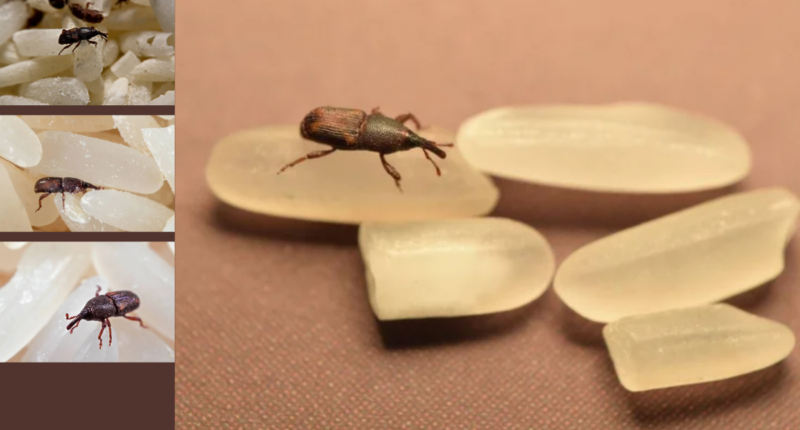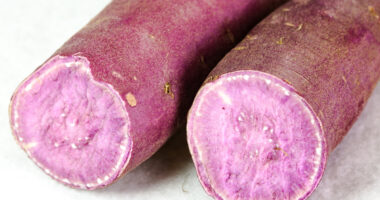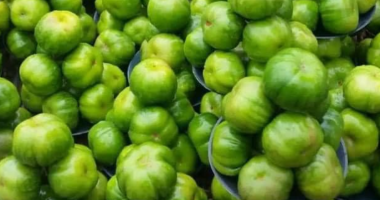Are Rice Weevils Harmful or Safe to Eat? Rice weevils (Sitophilus oryzae) are small, brown beetles that are a major pest of stored grains. They are found in many parts of the world, and they can infest a wide variety of food products, including rice, corn, wheat, beans, and nuts.
Adult rice weevils are about 2-3 mm long and have a distinctive snout. They are dark brown in color, with four reddish-yellow spots on their elytra (wing covers).
The life cycle of the rice weevil is about 3-4 months long. Adult females lay eggs in grain kernels. The eggs hatch into larvae, which feed on the grain. The larvae then pupate inside the grain, and the adult beetles emerge a few weeks later.
Rice weevils can cause significant damage to stored grains. They reduce the quality of the food by eating it, and they also contaminate it with their excrement. Infested grain may also develop a musty odor.
Where Do Rice Weevils Come From?
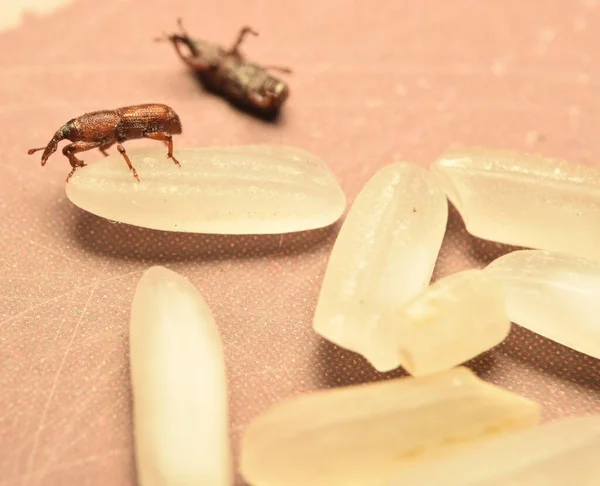
Rice weevils (Sitophilus oryzae) are thought to have originated in India, and they are now found in all warm and tropical parts of the world.
Rice weevils can be transported from one place to another in a number of ways, including:
- In infested food products. Rice weevils can be found in infested food products, such as rice, corn, wheat, beans, and nuts. If you buy food products that are infested with rice weevils, the weevils can spread to other food products in your home.
- In infested grain shipments. Rice weevils can also be found in infested grain shipments. If you live near a grain elevator or other facility that stores grain, there is a risk that rice weevils could be transported into your home on grain dust or other debris.
- In infested insects. Rice weevils can also be found in infested insects, such as beetles and moths. If you bring infested insects into your home, the rice weevils could spread to other food products.
Are Rice Weevils Harmful or Safe to Eat?
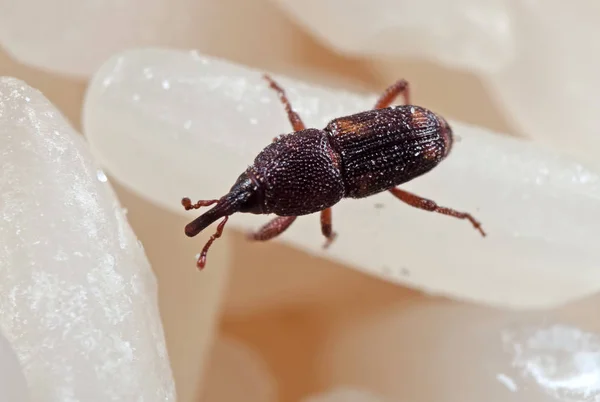
Rice weevils are not harmful to eat, they’re generally considered safe, although they are not typically consumed on purpose. While their presence in food products may be undesirable due to the potential for contamination, rice weevils are not harmful to humans if accidentally ingested.
Additionally, rice weevils do not bite, or sting and are not known to transmit diseases to humans, nor do they produce any toxins that can cause harm. However, consuming large quantities of weevils or their eggs may cause digestive discomfort or allergic reactions in some individuals. If rice is your favorite food then it’s important you learn about Ofada rice and the 5 Amazing Health Benefits Of Eating Ofada Rice
What Damage Do Rice Weevils Cause?
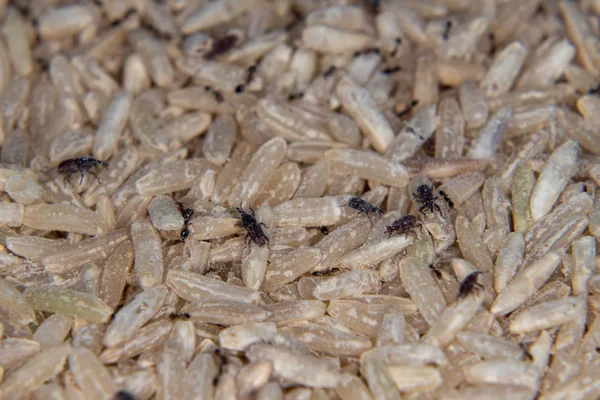
Some of the damages rice weevils cause include;
Grain Contamination: Rice weevils infest stored grains, including rice, by laying eggs inside the grains. As the eggs hatch, the larvae feed on the rice, causing physical damage and contaminating the grains with their excrement and cast-off skins.
Reduced Grain Quality: Infested rice grains often suffer from reduced quality due to the feeding activity of the weevil larvae. The larvae consume the inner portions of the grain, leading to a decrease in nutritional value and an increase in broken kernels, which can affect the appearance and texture of the rice.
Spoilage: Weevil infestations can result in spoilage of stored rice. The presence of weevils can accelerate the deterioration process, causing mold growth, off flavors, and unpleasant odors, rendering the rice unfit for consumption.
Economic Loss: Rice weevils can cause significant economic losses in agricultural and food storage sectors. Infestations can result in decreased crop yields, lower market value of affected grains, and additional costs associated with pest control measures and product disposal.
How to Prevent Rice Weevil Infestation
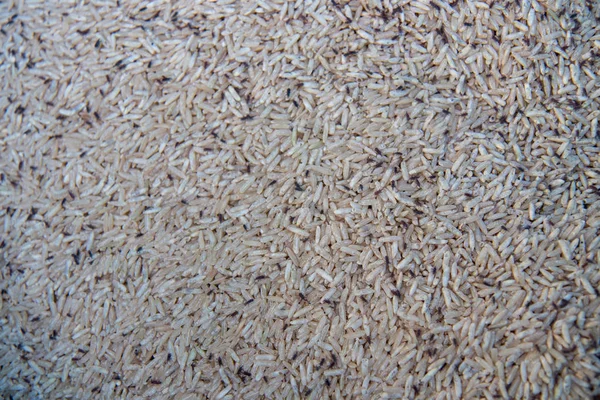
To prevent rice weevil infestation and protect your stored grains, including rice, follow these measures:
- Purchase Quality Grains: Buy high-quality grains from reputable sources. Ensure that the grains are free from any signs of damage or pests before purchasing.
- Inspect Before Storage: Before storing grains, thoroughly inspect them for any signs of infestation, such as live weevils, eggs, or webs. Discard any infested grains and use only clean, pest-free ones for storage.
- Store in Airtight Containers: Transfer grains to sturdy, airtight containers made of glass, plastic, or metal. Ensure that the containers have tight-fitting lids or seals to prevent weevils from entering or laying eggs. This step helps contain any potential infestations and prevents the spread to other stored foods.
- Clean Storage Areas: Before storing grains, clean and sanitize the storage area thoroughly. Remove any spilled grains, food debris, or residues that may attract pests. Vacuum or sweep the storage space, paying attention to corners, cracks, and crevices where weevils may hide.
- Temperature and Humidity Control: Weevils thrive in warm and humid environments. Maintain cool and dry conditions in your storage area to discourage weevil activity. Aim for a temperature below 20°C (68°F) and a humidity level below 50%, if possible.
- Rotate Stock: Practice the “first in, first out” rule by using older grains before newer ones. This rotation helps ensure that grains are used before their shelf life expires and reduces the risk of prolonged storage that can attract weevils.
- Monitor Regularly: Check stored grains periodically for any signs of weevil infestation. Look for live weevils, small holes in the grains, or fine webbing. Early detection allows for prompt action to prevent the infestation from spreading.
- Natural Pest Deterrents: Consider using natural pest deterrents such as bay leaves or neem leaves in your grain storage containers. These herbs are believed to repel weevils due to their strong scent.
- Professional Pest Control: If you have a severe or persistent weevil infestation problem, consult a professional pest control service. They can provide appropriate treatments and guidance to eliminate the infestation effectively.
By following these preventive measures, you can minimize the risk of rice weevil infestation and ensure the long-term storage of your grains.
How to Inspect Food for Weevils
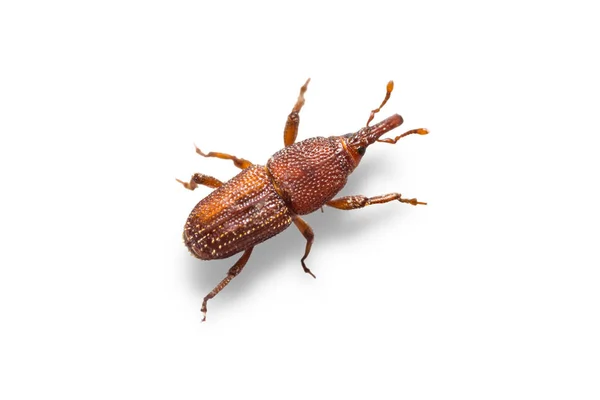
To inspect food for weevils, including rice, follow these steps:
- Prepare a Clean Work Area: Choose a well-lit area with a clean surface to perform the inspection. Wash your hands thoroughly before handling the food.
- Gather Necessary Tools: Get a white or light-colored tray or plate, a magnifying glass (optional but helpful), and a flashlight. These tools will assist in spotting any signs of weevils or infestation.
- Take a Sample: Take a small sample of the food you wish to inspect, such as a handful of rice grains, and place it on the tray or plate. If you suspect a specific area of the package, focus on that section.
- Observe Visual Signs: Examine the sample closely for any visual signs of weevils or infestation. Look for moving insects, which may appear as tiny dark-brown or black beetles with elongated bodies. Also, keep an eye out for small holes in the grains, fine webs, or unusual discoloration.
- Use Magnification: If available, use a magnifying glass to inspect the sample more closely. Weevils can be quite small, so magnification can help in detecting them or their eggs more easily.
- Check for Movement: Observe the sample for any signs of movement. Weevils may crawl or wriggle within the grains. Pay attention to the edges of the sample as they tend to gather there.
- Use a Flashlight: Shine a flashlight on the sample at different angles. The light may cause the weevils to move, making them more visible.
- Repeat the Process: If the initial sample appears clean, repeat the process with additional samples from different areas of the food package to ensure a thorough inspection.
- Dispose of Infested Food: If you discover weevils or signs of infestation, discard the infested food immediately. Do not consume or use it, as it may compromise the safety and quality of the food.
- Clean the Area: After completing the inspection, clean the work area, tray, and any utensils used. Properly dispose of the samples in a sealed bag or container to prevent further infestation.
Regularly inspecting your food for weevils helps identify any infestations early and allows you to take appropriate actions to prevent the spread of pests to other stored foods.
RELATED: Is White Rice Healthy? 7 Effects of Eating It
How to Get Rid of Rice Weevils
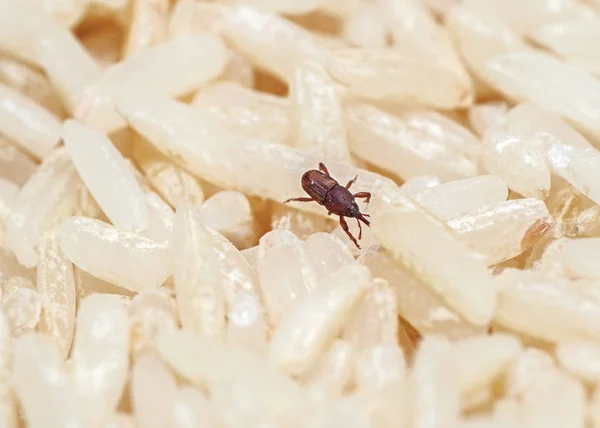
Although rice weevils are not harmful, still it’s pertinent to savage the situation should you notice them. If you have discovered rice weevils in your pantry, there are several natural remedies you can try to eliminate them:
Freezing Method
- Place the infested food item in a sealed plastic bag.
- Freeze the bag for at least four days to kill the weevils and their eggs.
- Thaw the food item and sift it through a fine mesh to remove any dead weevils or debris.
Bay Leaves
- Place bay leaves in your food storage containers.
- The strong aroma of bay leaves repels weevils and prevents infestation.
Diatomaceous Earth
- Sprinkle food-grade diatomaceous earth around the shelves and corners of your pantry.
- The sharp edges of diatomaceous earth damage the exoskeleton of weevils, causing dehydration and ultimately leading to their demise.
Vacuuming
- Regularly vacuum your pantry shelves and cracks to remove any weevils or eggs.
- Dispose of the vacuum bag immediately to prevent the weevils from reinfesting your pantry.
The next method is the chemical control methods because In severe infestations, natural remedies may not be sufficient, and you may need to resort to chemical control methods. Here are some options to consider:
Insecticides
- Choose an insecticide specifically labeled for rice weevils.
- Follow the instructions carefully when applying the insecticide.
- Ensure the treated area is well-ventilated and avoid direct contact with food items.
Pest Strips
- Use pest strips that contain a slow-release insecticide.
- Hang the strips in your pantry according to the manufacturer’s instructions.
- The fumes released by the strips will kill the weevils.
Aerosol Sprays
- Use aerosol sprays labeled for weevil control.
- Apply the spray directly into cracks, crevices, and areas where weevils are commonly found.
- Be cautious when using aerosol sprays in food storage areas and follow the instructions to prevent contamination.
Above all, If all measures fails or if you’re dealing with a persistent infestation, it may be necessary to seek professional pest control services. Pest control experts have the knowledge, experience, and specialized equipment to effectively eradicate rice weevils and prevent future infestations. After reading to know if rice weevils are harmful, next read about 10 Side Effects of Eating Rice Cakes – Disadvantages Or Cons To Know
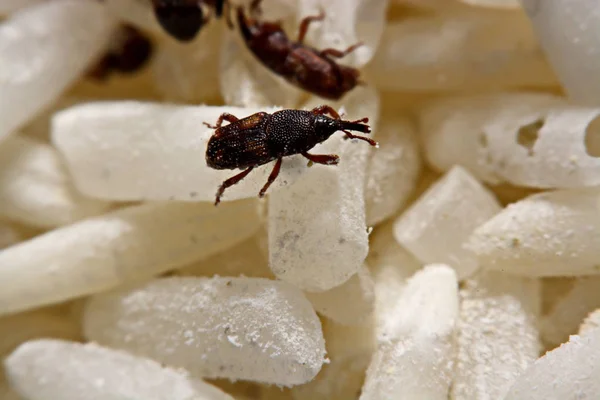
FAQs
Q: Are rice weevils attracted to specific types of grains?
A: Rice weevils can infest a wide range of grains, including rice, wheat, oats, barley, and corn. They are particularly attracted to whole grains and seeds, as they provide a suitable environment for their breeding and feeding.
Q: How long does it take to get rid of rice weevils using natural methods?
A: The duration to eliminate rice weevils using natural methods can vary depending on the severity of the infestation. It typically takes a few weeks to a couple of months to completely eradicate the weevils. Consistency in implementing the natural remedies and maintaining proper hygiene practices is essential for successful elimination.
Q: Is it safe to consume rice after a weevil infestation?
A: In most cases, rice that has been infested with weevils is still safe to consume after proper preparation. However, it’s recommended to discard infested portions and thoroughly inspect the remaining grains before cooking. Washing the rice thoroughly and cooking it at high temperatures will kill any potential bacteria or eggs that might be present.
Q: What other pests should I watch out for in my pantry?
A: Apart from rice weevils, there are other common pantry pests to be aware of, such as flour beetles, grain moths, and pantry ants. These pests can also infest stored grains and dried food items. Implementing preventive measures like proper storage, regular cleaning, and inspections will help keep your pantry protected from various types of pests.
